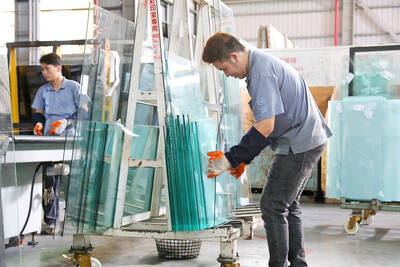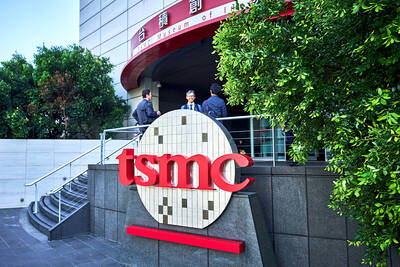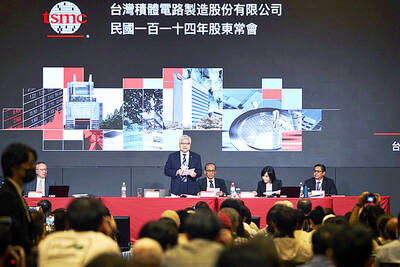Taiwan this year fell three places to 17th in a global competitiveness ranking by Lausanne, Switzerland-based International Institute for Management Development (IMD).
It was the lowest ranking since 2009, after Taiwan lost points in the areas of economic performance, foreign investment and the labor market, the business school said in its annual report.
The result placed Taiwan behind major trade rivals Hong Kong, Singapore and China, although it managed to stay ahead of South Korea and Japan.
The school graded 63 economies in terms of economic performance, government and business efficiency and infrastructure.
Taiwan’s economic showing dropped two places, dragged by a serious retreat in foreign investment, the report said, as corporate managers voiced concern that the global industrial realignment might dim its economic outlook.
Persistent overconcentration on a few export destinations and products weighed on the nation’s international trade ranking, even though account surpluses continued to support GDP growth, the school said.
Electronic components, especially semiconductors, underpinned the nation’s outbound shipments to major trading partners, with China taking a 40 percent share, government data showed.
Nations at the top of the ranking share an above-par performance across all competitiveness factors, despite a varied competitiveness mix, IMD World Competitiveness Center director Arturo Bris said.
Asian nations that have fallen in the ranking this year show a need to improve their tangible and scientific infrastructure, Bris added.
However, Taiwan is the exception, the school said on its Web site.
Taiwan’s business efficiency fell five positions to 20th, while the labor market score fell sharply, the report showed.
Labor rules that require higher overtime pay and shorter working hours have estranged corporate managers, the National Development Council said.
“The retreat is an alarm signaling an economic downturn. The government will press ahead with the pursuit of an inclusive economic growth model that will benefit all participants,” council Minister Chen Mei-ling (陳美伶) told a news conference.
It is not surprising that China outpaces Taiwan in competitiveness, because it has spent more money on enhancing infrastructure, Chen said.
The government has been removing regulatory barriers and introducing measures to attract foreign investment and talent, she said. “It might take more time for foreign research institutes to observe positive changes.”
Foreign investments and tourist numbers have showed signs of growth this year, while the government is considering relaxing immigration rules, she said, after IMD warned that the brain drain problem might hurt Taiwan if left unaddressed.
The nation’s competitiveness has stagnated, while other nations have gained headway, Taiwan Institute of Economic Research (台灣經濟研究院) economist Gordon Sun (孫明德) said.
Firms in China and elsewhere are recruiting skilled labor from Taiwan with better compensation offers, Sun said, adding that the issue merits more attention from policymakers and firms.

With an approval rating of just two percent, Peruvian President Dina Boluarte might be the world’s most unpopular leader, according to pollsters. Protests greeted her rise to power 29 months ago, and have marked her entire term — joined by assorted scandals, investigations, controversies and a surge in gang violence. The 63-year-old is the target of a dozen probes, including for her alleged failure to declare gifts of luxury jewels and watches, a scandal inevitably dubbed “Rolexgate.” She is also under the microscope for a two-week undeclared absence for nose surgery — which she insists was medical, not cosmetic — and is

CAUTIOUS RECOVERY: While the manufacturing sector returned to growth amid the US-China trade truce, firms remain wary as uncertainty clouds the outlook, the CIER said The local manufacturing sector returned to expansion last month, as the official purchasing managers’ index (PMI) rose 2.1 points to 51.0, driven by a temporary easing in US-China trade tensions, the Chung-Hua Institution for Economic Research (CIER, 中華經濟研究院) said yesterday. The PMI gauges the health of the manufacturing industry, with readings above 50 indicating expansion and those below 50 signaling contraction. “Firms are not as pessimistic as they were in April, but they remain far from optimistic,” CIER president Lien Hsien-ming (連賢明) said at a news conference. The full impact of US tariff decisions is unlikely to become clear until later this month

GROWING CONCERN: Some senior Trump administration officials opposed the UAE expansion over fears that another TSMC project could jeopardize its US investment Taiwan Semiconductor Manufacturing Co (TSMC, 台積電) is evaluating building an advanced production facility in the United Arab Emirates (UAE) and has discussed the possibility with officials in US President Donald Trump’s administration, people familiar with the matter said, in a potentially major bet on the Middle East that would only come to fruition with Washington’s approval. The company has had multiple meetings in the past few months with US Special Envoy to the Middle East Steve Witkoff and officials from MGX, an influential investment vehicle overseen by the UAE president’s brother, the people said. The conversations are a continuation of talks that

CHIP DUTIES: TSMC said it voiced its concerns to Washington about tariffs, telling the US commerce department that it wants ‘fair treatment’ to protect its competitiveness Taiwan Semiconductor Manufacturing Co (TSMC, 台積電) yesterday reiterated robust business prospects for this year as strong artificial intelligence (AI) chip demand from Nvidia Corp and other customers would absorb the impacts of US tariffs. “The impact of tariffs would be indirect, as the custom tax is the importers’ responsibility, not the exporters,” TSMC chairman and chief executive officer C.C. Wei (魏哲家) said at the chipmaker’s annual shareholders’ meeting in Hsinchu City. TSMC’s business could be affected if people become reluctant to buy electronics due to inflated prices, Wei said. In addition, the chipmaker has voiced its concern to the US Department of Commerce